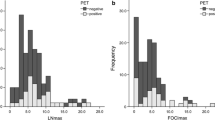Abstract
A total of 211 patients with gastric cancer in the upper third of the stomach were clinicopathologically evaluated. Of the 211 patients, 82 had esophageal infiltration and 129 did not. These two groups were compared. The study on patients who had undergone resection and radioisotope (99mTc-phytate) uptake testing revealed that it was important to dissect the lymph nodes (predominantly nodes 7,9,11, and 16) during surgery in the patients with gastric cancer plus esophageal infiltration. When cancer infiltration of the esophagus exceeds 1 cm, the preferred surgical procedure is lower esophagectomy and total gastrectomy with abdominal and intrathoracic lymphadenectomy via the left thoracoabdominal approach. When residual cancer is suggested in the more proximal esophageal stump due to intramural metastasis from vascular invasion, rapid pathologic diagnosis should be made by frozen sections during surgery and then subtotal esophagectomy by blunt removal of the esophagus proximally from the aortic arch using a left thoracotomy considered.
Résumé
Dans une population de patients ayant un cancer du tiers proximal de l'estomac, nous avons comparé les données clinicopathologiques entre 82 avec une infiltration du bas oesophage et 129 sans une telle infiltration. La résection chirurgicale et le comptage radioisotopique (99mTc-phytate) nous ont permis de constater qu'il importe d'enlever surtout les ganglions 7, 9, 11 et 16 dans le curage accompagnant la résection pour cancer gastrique envahissant le bas oesophage. Lorsque l'envahissement du bas oesophage dépasse un centimètre, il faut préconiser une gastrectomie totale et une oesophagectomie inférieure combinées a un curage abdominal et thoracique par une thoracotomie gauche. Lorsqu'un envahissement intramural d'origine vasculaire est détecté sur la tranche de section par examen extemporané, il faut envisager de compléter l'oesophagectomie au dela de la crosse de l'aorte.
Resumen
Hemos realizado la evaluación clinicopatológica de pacientes con cáncer del tercio superior del estómago, comparando 82 que presentaban infiltración del esófago y 129 sin extensión del esófago.
El estudio de los pacientes sometidos a resección con captación de radioisótopo (99 mTc-fitato) reveló que la disección de los ganglios linfáticos, predominantemente los grupos 7, 9, 11 y 16 fue importante para la cirugía radical realizada en los casos de cáncer gástrico con infiltración del esófago. Cuando la infiltración del esófago excede 1 cm, el procedimiento quirúrgico de escogencia es la esofagectomía distal + gastrectomía total con linfadenectomía abdominal e intratorácica por vía toracoabdominal izquierda. Cuando exista la sugerencia de tumor residual en el cabo esofágico proximal pro metástasis intramurales a partir de invasión vascular, se debe practicar un rápido corte por congelación y proceder con una esofagectomía subtotal mediante disección proximal del esófago desde el arco aórtico, por toracotomía izquierda.
Similar content being viewed by others
References
Papachristou, D.N., Agnanti, N., D'Agostino, H., Fortner, J.G.: Histologically positive esophageal margin in the surgical treatment of gastric cancer. Am. J. Surg. 139:711, 1980
Takeshita, K., Habu, H., Saito, N., et al.: Endoscopic evaluation of gastric cancer infiltrating the lower esophagus. Surg. Endosc. 6:62, 1992
Japanese Research Society for Gastric Cancer: The general rules for the gastric cancer study in surgery and pathology. Jpn. J. Surg. 11:127, 1981
Japanese Society for Esophageal Diseases: Guide lines for the clinical and pathologic studies on carcinoma of the esophagus. Jpn. J. Surg. 6:69, 1976
Blot, W.J., Devesa, S.S., Kneller, R.W., Fraumeni, J.F.: Rising incidence of adenocarcinoma of the esophagus and gastric cardia. J.A.M.A. 265:1287, 1991
Powell, J., McConkey, C.C.: Increasing incidence of adenocarcinoma of the gastric cardia and adjacent sites. Br. J. Cancer 62:440, 1990
Husemann, B.: Cardia carcinoma considered as a distinct clinical entity. Br. J. Surg. 76:136, 1989
Finley, R.J., Inculet, R.I.: The results of esophagogastrectomy without thoracotomy for adenocarcinoma of the esophagogastric junction. Ann. Surg. 210:535, 1989
Blomjous, J.G.A.M., Hop, W.C.J., Langenhorst, A.M., Ten Kate, F.J.W., Eykenboom, W.M.H., Tilanus, H.W.: Adenocarcinoma of the gastric cardia. Cancer 70:569, 1992
Goldfaden, D., Orringer, M.B., Appelman, H.D., Kalish, R.: Adenocarcinoma of the distal esophagus and gastric cardia. J. Thorac. Cardiovasc. Surg. 91:242, 1986
Misumi, A., Misumi, K., Harada, K., Murakami, A., Kondo, H., Akagi, M.: Transabdominal operation for carcinoma of the gastric cardia: application of pulling-up retractor and EEA stapler. Int. Surg. 74:223, 1989
Habu, H., Kando, F., Saito, N., et al.: Experience with the EEA stapler for esophagojejunostomy. Int. Surg. 74:73, 1989
Smith, J.W., Shiu, M.H., Kelsey, L., Brennan, M.F.: Morbidity of radical lymphadenectomy in the curative resection of gastric carcinoma. Arch. Surg. 126:1469, 1991
Griffin, S.M., Chung, S.C.S., Woods, S.D.S., Li, A.K.C.: Adenocarcinoma of the cardia: treatment by thoracoabdominal R3 radical gastrectomy. Br. J. Surg. 77:937, 1990
Paolini, A., Tosato, F., Cassese, M., et al.: Total gastrectomy in the treatment of adenocarcinoma of the cardia. Am. J. Surg. 151:238, 1986
Sons, H.U., Borchard, F.: Cancer of the distal esophagus and cardia. Ann. Surg. 203:188, 1986
Kitamura, M., Arai, K., Miyashita, K.: Clinicopathological characteristics of cases with metastasis to lower mediastinal lymph nodes and treatment in gastric cancer with esophageal invasion. Jpn. J. Gastroenterol. Surg. 25:2449, 1992 [in Japanese with English abstract]
Natsugoe, S.: Experimental and clinical study on the lymphatic pathway draining from the distal esophagus and gastric cardia. J. Jpn. Surg. Soc. 90:364, 1989 [in Japanese with English abstracts]
Aikou, T., Shimazu, H.: Difference in main lymphatic pathways from the lower esophagus and gastric cardia. Jpn. J. Surg. 19:290, 1989
Kohno, Y.: On the lymphatics of the cardia—in special reference to the study using endoscopic lymphoscintigraphy with SPECT. J. Jpn. Surg. Soc. 88:686, 1987 [in Japanese with English abstracts]
Yamazaki, S., Sato, T.: On the lymphatics of the transitional zone of the esophagus and stomach. Jpn. J. Lymphol. 8:175, 1985 [in Japanese with English abstracts]
Keighley, M.R.B., Moore, J., Lee, R., Malins, D., Thompson, H.: Peroperative frozen section and cytology to assess proximal invasion in gastro-oesophageal carcinoma. Br. J. Surg. 68:73, 1981
Author information
Authors and Affiliations
Rights and permissions
About this article
Cite this article
Takeshita, K., Ashikawa, T., Tani, M. et al. Clinicopathologic features of gastric cancer infiltrating the lower esophagus. World J. Surg. 18, 428–432 (1994). https://doi.org/10.1007/BF00316829
Issue Date:
DOI: https://doi.org/10.1007/BF00316829




